City gardeners need plants that perform — that look aesthetically pleasing (or at least not conspicuously ugly) over multiple seasons, that dazzle and pop when in bloom, and that aren't too fussy. We don't have the acreage for flowery mixed borders or large swaths of perennials that take turns shining like a procession of shooting stars.

Bald cypress and palms
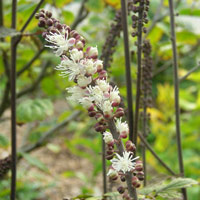
Kamchatka bugbane
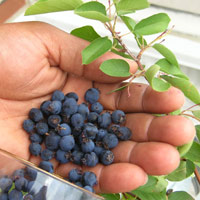
Harvesting serviceberries
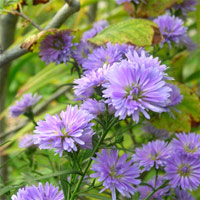
Milka aster
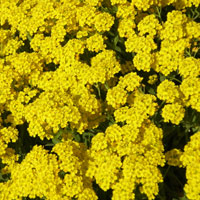
Basket-of-gold

Sweet autumn clematis (seed heads)
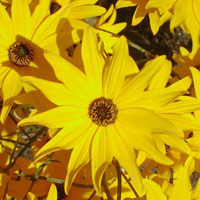
Dwarf swamp sunflower
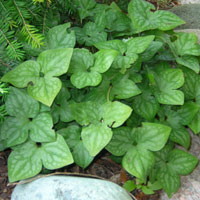
Hepatica
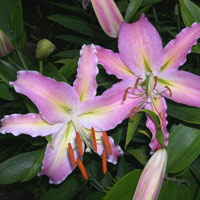
'Tom Pouce' lily

Petunia

Sedum (with tulips)
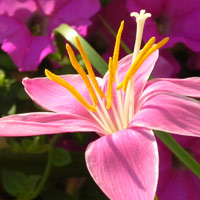
Rain lily
Fantastic plants like Joe-Pye weed, 'Raydon's Favorite' aster, Jerusalem artichoke, tiger lily, and angelica are too big and aggressive for city living. Daffodils, trilliums, and colchicums have enchanting blooms but are too ephemeral to be allotted much space here. The mainstays of an urban garden must be workhorses that endure cold and heat, rain and sleet, and the occasional feet.
Through the years I have tried hundreds of plants in Chicago with glorious successes and shocking failures. Listed below are my top 12 plants that give high return for the space.
| Plant | Urban Conditions | |||
| Shade Tolerant | Drought Tolerant | Tolerant of Compaction | Suitable for Containers | |
| Bald cypress | No | No | Yes | No |
| Kamchatka bugbane | Yes | No | Yes | No |
| 'Regent' serviceberry | No | Yes | Yes | Yes |
| Milka aster | No | Yes | Yes | Yes |
| Basket-of-gold | No | Yes | No | Yes |
| Sweet autumn clematis | No | Yes | Yes | No |
| Dwarf swamp sunflower | No | No | Yes | No |
| Hepatica | Yes | Yes | Yes | No |
| 'Tom Pouce' lily | Yes | No | Yes | No |
| Petunia | No | Yes | No | Yes |
| Sedum | No | Yes | Yes | Yes |
| Rain lily | Yes | Yes | Yes | Yes |
Bald Cypress (Taxodium distichum) is a large shade tree that works well in an urban environment because it's tolerant of compacted soils and air pollution. These Southern swamp denizens are hardy to at least zone 5 and capable of growing in completely waterlogged clay, although they will do just fine in average soil.
The feathery, lime green new growth brightens the area in spring. In fall the foliage turns reddish brown and the female trees drop their decorative seedpods. In winter the peeling bark and pyramidal shape add interest to the landscape.
Urban gardeners without the space for a large shade tree can choose the outstanding variety T. distichum 'Peve Minaret', which grows only 8 feet high and is suitable for a large container.
Kamchatka bugbane (Actaea ramosa cultivars) is a year-round workhorse perennial. It offers decorative foliage, structure, and fragrant flowers, giving it three-season appeal. In early spring the feathery foliage emerges greenish burgundy and develops into a substantial mound by summer. In late autumn, sweet-scented, bottlebrush flowers begin to bloom on 4-foot stalks. In cold northern climates, gardeners should cut some flowers for indoors as soon as they begin to open, because hard frost often halts the flowering. Give it full sun or part shade and moist soil.
'Regent' serviceberry (Amelanchier 'Regent'), also called Juneberry, is a small shrub suitable for yards and containers. 'Regent' serviceberry is a problem-solver, growing happily in sunny, dry, and windy areas like balconies and roof decks. As a container plant on my balcony, it withstands both torrid summers and frigid winters that have killed many lesser shrubs.
'Regent' serviceberry is one of the few ornamental edibles urban gardeners can grow. Clusters of white flowers cover the branch tips in spring. Bumblebees and flies take care of pollination, and soon tiny green berries appear. By early June, they are ripening to shades of red and deep violet. Serviceberries are similar to blueberries in both taste and use.
By early autumn the leaves are changing to shades of yellow, red, and tan. The bare branches add structure and the promise of life to my otherwise barren balcony in winter.
Milka aster (Aster novi-belgii 'Milka') is a mid-sized perennial for borders and berms. Full sun and average-to-dry soil are required. Aster Milka is inconspicuous in spring and summer, but in autumn the fully double flowers (available in several different colors) open and last until Thanksgiving. In peak bloom aster Milka looks like a big powder puff.
Basket-of-gold (Aurinia saxatillis) is an evergreen perennial or subshrub needing full sun and excellent drainage. It's fantastic in containers if given a well-drained potting mix, and it will brave the summer and winter outside. This hardy, drought-tolerant, and pest-resistant plant is a workhorse for city gardeners. The fuzzy, grayish foliage is attractive year-round. In spring, basket-of-gold is covered in fragrant, yellow flowers that last for more than two weeks.
Sweet autumn clematis (Clematis paniculata) is a large climbing vine that works great on trellises, arbors, and chain-link fences. It needs full sun and average moisture for peak performance. City gardeners can use sweet autumn clematis to quickly cover fences and provide green screening. In autumn it bursts into bloom with thousands of fragrant white stars. Sweet autumn clematis in full glory on a crisp September morning is one of the true wonders of nature.
Dwarf swamp sunflower (Helianthus angustifolia cultivars) is a medium-sized perennial for borders and garden beds. It is not a multi-season plant, but its prolific bloom, manageable size, and easy care earn it a spot here. It grows to about 5 feet, and its leaves offer a green backdrop for early-summer bloomers. Like sweet autumn clematis, it explodes in autumn. Scores of golden yellow flowers completely drape the plant for weeks until hard frost knocks it down. Throughout winter the seed heads (although not decorative) attract hungry finches.
Hepatica (Hepatica acutiloba) is a small, semi-evergreen wildflower suitable for underplanting with trees and shrubs. These tough, hardy plants can withstand dry and shady conditions. Established hepaticas pop into bloom in early spring with dozens of bright, anemone-like flowers. The decorative, mottled leaves follow about a week later. Throughout summer and fall, hepaticas remain compact and attractive.
'Tom Pouce' Oriental lily (Lilium 'Tom Pouce') is a hardy bulb used in garden beds and borders. Many beautiful, carefree bulbs are not on this list because of their ephemeral nature, but lilies actually have a presence for most of the growing season. 'Tom Pouce' has large, multi-hued (yellow, white, lavender), fragrant flowers on sturdy 3- to 4-foot stems. By summer they are like shapely candelabras in the garden, with a heavy fragrance that wafts across the sultry July air. Just one cut flower will perfume a whole room.
'Tom Pouce' needs full sun to part shade with average moisture, and protection from strong winds. This is not a balcony plant. Some afternoon shade will help prolong flowering.
Petunia (Petunia cultivars) is a tropical plant used as an annual in garden beds, hanging baskets, and containers. Petunias are simply riots of color and indispensable in an urban garden. Once they begin to bloom in late spring, petunias will continue till frost.
Sedum (Sedum album) is an evergreen, sun-loving ground cover that's one of the most drought-tolerant and pest-resistant plants. It's the only sedum I grow that the rabbits did not eat last winter. The bright green, stubby, succulent leaves look lively all year. It spreads quickly to form a dense mat that helps smother weeds. The short panicles of white flowers in summer are nice, but the foliage and form is why sedum makes the grade.
Rain lily (Zephyranthes grandiflora) is subtropical bulb ideal for containers or the front of a garden bed. Rain lilies emerge in mid-spring with grass-like foliage, then begin to bloom in early summer. Established pots can bloom off and on all season. Unlike most plants, rain lilies work well in containers without drainage holes. This keeps a steady supply of water available for the roots. In late autumn bring the pots into an area that will not go below 28 degrees F. Bring the pot back outside after St. Patrick's Day.
These are but a few of the tried-and-true plants for urban settings. Combine them with your favorite bulbs and annuals and you'll have a colorful and fragrant garden to enjoy all summer and beyond.